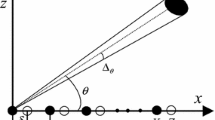Abstract
We present an algorithm for two-dimensional (2D) direction-of-arrival (DOA) estimation of noncircular sources using an L-shaped sparse array. An L-shaped sparse array consisting of two co-prime arrays is firstly introduced. Then, the fourth-order-cumulants (FOCs) of received data are used to construct a FOC matrix (FOCM), by which we can get the estimations of elevation angles. With the estimated elevation angles, the azimuth angles can be estimated by a low-complexity signal separation algorithm. During the procedure used for estimating azimuth angles, no any eigenvalue decomposition (EVD), peak search and pair-matching procedure need to be implemented. Although the aperture is extended significantly, the computation complexity of proposed algorithm still is acceptable. Compared with some analogous algorithms, our approach shows more attractive estimation performance. A lot of simulation results prove the advantages of proposed DOA estimation technology.







Similar content being viewed by others
References
Abeida, H., & Delmas, J. P. (2006). MUSIC-like estimation of direction of arrival for noncircular sources. IEEE Transactions on Signal Processing, 54(7), 2678–2690.
Camps, A., Cardama, A., & Infantes, D. (2002). Synthesis of large low redundancy linear arrays. IEEE Transactions on Antennas and Propagation, 49(12), 1881–1883.
Charge, P., Wang, Y., & Saillard, J. (2001). A noncircular sources direction finding method using polynomial rooting. Signal Processing, 8, 1765–1770.
Chen, C. Y., & Vaidyanathan, P. P. (2008). Minimum redundancy MIMO radars. IEEE International Symposium on Circuits and Systems, 1, 45–48.
Delmas, J. P., & Abeida, H. (2004). Stochastic Cramér-Rao bound for noncircular signals with application to DOA estimation. IEEE Transactions on Signal Processing, 52(11), 3192–3199.
Gan, L., Gu, J. F., & Wei, P. (2008). Estimation of 2-D DOA for noncircular sources using simultaneous SVD technique. IEEE Antennas Wireless and Propagate Letters, 7, 385–388.
Gou, X. M., Liu, Z. W., & Xu, Y. G. (2013). Biquaternion cumulant-MUSIC for DOA estimation of noncircular signals. Signal Processing, 93(4), 874–881.
Gounon, P., Adnet, C., & Galy, J. (1998). Angular localization for non-circular signals. Traitement du Signal, 15(1), 17–23.
Gu, J. F., Gan, L., & Wei, P. (2007). Joint SVD of two cross-correlation matrices to achieve automatic pairing in 2-D angle estimation problems. IEEE Antennas Wireless Propagate Letters, 6, 553–556.
Haardt, M., & Romer, F. (2008). Enhancements of unitary ESPRIT for non-circular sources. In Proceeding of 2004 IEEE international conference on acoustics, speech and signal processing, Montreal, Quebec, Canada, May 2004, pp. 101–104.
Hua, Y., Sarkar, T. K., & Weiner, D. D. (1991). An L-shaped array for estimation 2-D directions of wave arrival. IEEE Transactions on Antennas and Propagate, 39(2), 143–146.
Huang, X., Guo, Y. J., & Bunton, J. D. (2010). A hybrid adaptive antenna array. IEEE Transactions on Wireless Communication, 9(5), 1770–1779.
Liu, J., Huang, Z. T., & Zhou, Y. Y. (2007). Azimuth and elevation estimation for noncircular signals. IET Electronics Letters, 43(20), 1117–1119.
Liu, S., Yang, L. S., Chen, Z. X., Xu, J., & Yin, Y. H. (2015). Two-dimensional direction of arrival estimation using a co-prime L-shaped array. ICIC Express Letters, 9(11), 3101–3106.
Marcos, S., Marsal, A., & Benidir, M. (1995). The propagator method for source bearing estimation. Signal Processing, 42(2), 121–138.
Min, S., Seo, D., Lee, K. B., Kwon, H. M., & Lee, Y. H. (2004). Direction-of-arrival tracking scheme for DS/CDMA systems: Direction lock loop. IEEE Transactions on Wireless Communication, 3(1), 191–202.
Nie, X., & Li, L. P. (2014). A computationally efficient subspace algorithm for 2-D DOA estimation with L-shaped array. IEEE Signal Processing Letters, 21(8), 971–974.
Pal, P., & Vaidyanathan, P. P. (2010). Nested arrays: A novel approach to array processing with enhanced degrees of freedom. IEEE Transactions on Signal Processing, 58(8), 4167–4181.
Roy, R., & Kailath, T. (1989). ESPRIT-estimation of signal parameters via rotational invariance techniques. IEEE Transactions on Acoustics Speech and Signal Processing, 37(7), 984–995.
Schmidt, R. O. (1986). Multiple emitter location and signal parameter estimation. IEEE Transactions on Antennas and Propagation, 34(3), 276–280.
Stoica, P., & Selen, Y. (2004). Model-order selection: A review of information criterion rules. IEEE Signal Processing Magazine, 21(4), 6–47.
Vaidyanathan, P. P., & Pal, P. (2011). Sparse sensing with co-prime samplers and arrays. IEEE Transactions on Signal Processing, 59(2), 573–586.
Weng, Z. Y., & Petar, M. D. (2014). A search-free DOA estimation algorithm for co-prime arrays. Digital Signal Processing, 24, 27–33.
Yang, Z., Xie, L. H., & Zhang, C. S. (2013). Off-grid direction of arrival estimation using sparse Bayesian inference. IEEE Transactions on Signal Processing, 61(1), 38–43.
Yang, X. M., Li, G. J., Zheng, Z., & Zhong, L. (2014). 2D DOA estimation of coherently distributed noncircular sources. Wireless Personal Communication, 78, 1095–1102.
Yin, J. H., & Chen, T. (2011). Direction-of-arrival estimation using a sparse representation of array covariance vectors signal processing. IEEE Transactions on Signal Processing, 59(9), 4489–4493.
Zhang, X. F., Li, J. F., & Xu, L. Y. (2011). Novel two-dimensional DOA estimation with L-shaped array. EURASIP Journal on Advances in Signal Processing, 50, 1–7.
Acknowledgments
The work was supported by the National Natural Science Foundation of China (Grant Nos. 61501068, 61301120 and 51377179), by Foundation and Advanced Research Projects of Chongqing Municipal Science and Technology Commission under Grant cstc2015jcyjA40001, by the Fundamental Research Funds for the Central Universities (Grant Nos. 106112015CDJXY500001, CDJPY12160001), and by the Natural Science Foundation Project of CQ CSTC (CSTC2011GGYS0001).
Author information
Authors and Affiliations
Corresponding author
Rights and permissions
About this article
Cite this article
Liu, S., Yang, L., Li, D. et al. 2D DOA estimation for noncircular sources using L-shaped sparse array. Multidim Syst Sign Process 29, 489–502 (2018). https://doi.org/10.1007/s11045-016-0402-7
Received:
Revised:
Accepted:
Published:
Issue Date:
DOI: https://doi.org/10.1007/s11045-016-0402-7




